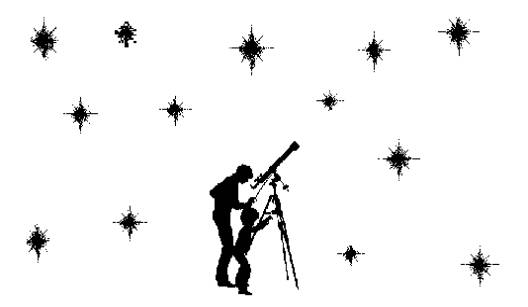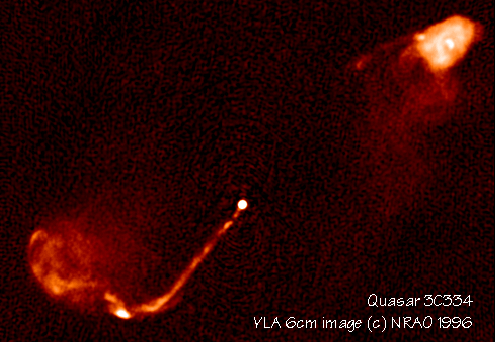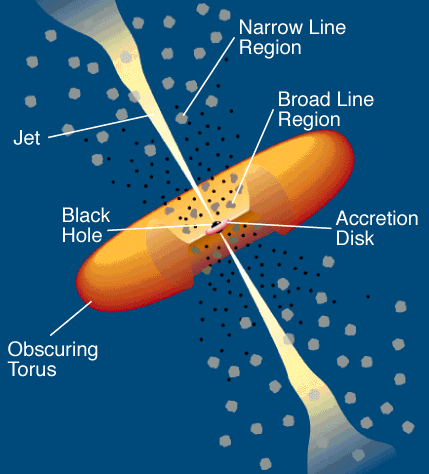
The Wall Magazine
2002-2003 III

|
Club Coordinators |
Other Contributors |
|
1. Amar V. Chandra |
1. Dr. Pankaj Jain (Faculty Advisor, Astronomy Club) |
|
2. Ashutosh Kumar Gupta |
2. Vinay Mishra |
|
3. Jaya Jha |
3. Prateek Jain |
|
|
4. Archisman Ghosh |
Active Galactic Nuclei (AGN) are some of the most
powerful objects seen in the sky.
As the name suggests, the centers of these galaxies show considerable activity
in contrast to the milky way whose
center is quiet. AGNs are categorized into four broad classes, namely, Seyfert
galaxies, Radio galaxies, Quasars and Blazars. A significant fraction of these
objects, particularly the quasars, are seen at redshifts larger than 1. By Hubble's
law, such large resdhifts translate into
distances of order 1 Gpc (Giga parsec). This distance may be compared with the
diameter of the disc of the milky way which is about 30 kpc and the size of the
universe which is about 10 Gpc.
The bolometric (integrated over wavelength) luminosity of
a typical quasar is approximately 1000 times greater than that of the milky way.
This is particularly impressive if one realizes that this
mission comes dominantly from a region about 10 A. U. (Astronomical
Units), which is about 8 orders of magnitude smaller than the disc diameter of
the milky way. Due to this large luminosity, quasars appear as star like objects
despite being so far away from us and hence the name Quasi Stellar Objects (QSOs)
or Quasars. It is interesting to note that, in contrast to stars, the dominant
source of energy in AGNs is not nuclear fusion. Instead the energy is generated
by the release of gravitational potential energy due to fall of material towards
the core of the AGN. The size and mass
of the emission region suggests that a very massive black hole, with mass of the
order of 108 solar masses resides in the center of the AGN and is
responsible for the release of the large amount of gravitational potential
energy.
The AGNs, therefore consist of a core or the central
engine surrounded by an accretion disk through which matter is continuously
falling towards the black hole. Furthermore they emit jets of relativistic
particles, somewhat analogous to the jets emitted by pulsars. If the central
engine is visible to the observer then the object appears as a quasar. If the
jet directly beams towards the observer then the object is called a blazar. The
Seyfert galaxies are somewhat less active compared to other AGNs. They appear as
Seyfert I or Seyfert II depending on whether the central engine is directly
visible to the observer or hidden from view by the accretion disk.
The radio emitting region of AGNs is called the radio galaxy.
Another remarkable fact about the AGNs is their spectrum, which is characteristically non thermal. The spectrum ranges all the way from radio waves to x-rays and higher frequencies. The radio waves are emitted in the form of synchrotron radiation when jets of charged particles emitted by the AGN interact with the surrounding nebula. Some picture of radio galaxies and quasars in radio frequencies are shown below.

Figure 1

Figure
2

Figure
3

Figure
4
: AGN Model
Dr. Pankaj Jain, Professor, Department of Physics
Faculty
Advisor, Astronomy Club
But you can quote this one:The true purpose of astronomy is
not to add to the vulgar comforts of life, but to raise the mind to the
contemplation of things which can be perceived by pure intellect alone (Plato
427-347
BC)
1.
Sometimes why do we see a full disc of moon on a half moon day?
2.
What are auroras(The lighting that is usually seen near poles)?
3.
Why can we see sunlight for over 20 minutes after the sun-set?
4.
Why is Venus hotter than Mercury, though the later is closer to the sun?
5.
Why is the colour of a fully eclipsed moon red?
1.
If you wear sunglasses all the time - even indoors because you don't want
to lose your night vision.
2.
If, in your opinion, the Earth is merely an unfortunate
obstacle which blocks half of the universe at given time.
3.
If you enjoy sleep deprivation.
4.
If you celebrated in February 1999, when Pluto became the
"ninth" planet again.
5.
If you yearn to destroy the moon - not only because of the
light pollution it causes, but so that Earth could have a lovely ring system
like all the "really cool" planets.
6.
If you've proposed a NASA mission to "correct" the
retrograde orbit of Triton.
7.
If you have nightmares about the giant black hole that may be
lurking in the center of our galaxy.
8.
If you're looking forward to Vega becoming our new north star
13,000 years from now.
9.
If, after reading the previous indicator, you checked to make
sure the math was right.
10.
If you've had a fist-fight over the value of the Hubble
Constant.
11.
If you'd prefer to live in the Andromeda Galaxy - just
because it's bigger.
12.
If you actually care whether or not the universe is
"flat."
13.
If, when people ask where you live, you give them a latitude
and longitude to five decimal places.
14.
If you know how to use a planisphere, but can't fold a road
map.
15.
If, when someone asks you what time it is, you stare up at
the sun and estimate the time based on its position... despite the fact that you
are wearing a watch.
16.
If you'll use an argument that is physically unjustifiable
and mathematically erroneous as long as it gives the "right answer."
17.
If you begin to classify people as "elliptical",
"spiral", or "irregular."
18.
If you have the Hubble Deep Field as the background for your
web page or Windows desktop.
19.
If your self-esteem is derived entirely from the number of
deep sky objects you can find without using coordinates.
20.
If, when you drop your keys behind your chair, you begin to
look for them under your bed because it would be "more interesting" if
you found them there.
21.
If your eyes have become hypersensitive due to lack of
exposure to sunlight.
22.
If you've never bothered to memorize your own middle name
because you know you can either look it up, or derive it from first principles
if necessary.
23.
If you actually understood a majority of these indicators.
If these indicators apply to you,
you just might be an astronomer. You may want to seek professional help. I hope
this clears up any confusion.
Astronomers have always tried to understand the
evolvement of stars, Galaxies and Universe itself. Stars are born in very thin
medium that is spread across the Universe i.e. Interstellar Medium. So if one
knows the properties and composition of interstellar medium in the nearby region
of a star then it is quite handy to predict the nature of distant stars .One of
the most efficient methods that is used by the
astronomers is "Radio Recombination Lines".
The principle behind the origin of these lines is simple,
a hot luminous object ionizes hydrogen (that is most abundant in interstellar
medium) in its nearby region and creates a combined state of electrons and
hydrogen nucleus (i.e. protons). These regions are called HII regions(for H+
conventionally). Due to the tendency to recombine, e- and
p+ interact and electron get combined in some higher state of hydrogen
and cascades down slowly towards ground state in hydrogen atom. It so happens
that if the principal quantum no. n >=40 then the frequency emitted by the
electrons fall in the Radio region, which we can observe, That's why it is
called Radio Recombination Lines.
The existence of such lines was first predicted by
Kardashev in 1959 and in 1965 it was experimentally verified. RRLs are used in
studies because of no dust oscuration in transmission of these lines ,it is the
best way so far to study extragalactic objects and even for the studies relating
to our own galactic center. Since all HII regions RRL fall in nearly LTE (local
thermodynamic equilibrium) conditions so it is easy to adopt methods which are
available.
There are RRLs for other atoms also such as for Carbon,
Helium etc.
The best use of RRLs for future research possibly is to
study RRLs in Sun's photosphere region and High Red Shift Quasars which will
solve the mysterious problem of "How our Universe evolved?"
∑
What would happen to an astronaut if he tripped
and fell into a black hole? He would be stretched like a piece of
spaghetti! The closer he gets to the black hole, the stronger the force of
gravity would be. In fact, the pull of gravity increases so fast, that the
gravity tugs on his feet more than on his shoulders. With his feet being pulled
into the black hole faster than her shoulders, he would be stretched out farther
and farther.
∑
That a massive body 100km wide traveling at over 512,000km/h
crashed into Mercury to form the Caloris Basin *. The impact was so great it
sent shockwaves round Mercury creating its hilly lineated terrain
∑
That a Supernova explosion produces more energy in its first
ten seconds than the Sun during the whole of its 10 billion year lifetime and
that for a brief period, it creates more energy than the rest of a galaxy put
together!!
*Caloris Basin is the largest surface feature on Mercury. Caloris is Latin for heat, and the basin is named so because it is near the sub solar point (the point closest to the sun), when Mercury is at perihelion (the closest point in its orbit to the sun).